Speech The Economic Transition in China

Christopher Kent[*]
Assistant Governor (Economic)
Economic Society of Australia (QLD) Business Lunch
Brisbane –
Introduction
I would like to thank the Queensland branch of the Economic Society of Australia for hosting this event. It is a pleasure to be back here to discuss the economic transition in China.
This topic is important for the Australian economy, where economic activity is rebalancing toward non-mining sectors following the end of the commodity price boom. Indeed, this process is well advanced. The latest data suggest that non-mining activity is growing a little faster than GDP.
Much of the original impetus for the commodity price boom came from the rapid rise in China's demand for raw materials. Eventually, the global supply of commodities increased, including supply from the resource-rich states of Queensland and Western Australia. In turn, rising supply led to an inevitable decline in commodity prices. Although prices are still well above where they were before the boom, the extent of the decline over the past few years has been larger than most people expected.
In part, that reflects an easing in China's demand for commodities over the past year or two. This has occurred against the backdrop of a moderation in Chinese economic growth more broadly. The slowing in growth had been widely anticipated within China and by outside observers. It is a natural consequence of China moving beyond the rapid phase of growth associated with industrialisation.
There is, however, considerable uncertainty and debate around the extent to which imbalances that have become increasingly evident will affect the sustainability of China's growth over the coming decade. Key concerns are the economy's reliance on investment as a source of demand and on debt as a source of funding for that investment.
Our central forecast, which is similar to those of many observers, is that the Chinese economy will experience a further gradual moderation in growth over the next few years.[1] The Chinese authorities intend to keep overall growth close to its current level for the remainder of the decade. However, there appear to be increasing tensions between the goals of shoring-up short-term growth and pursuing institutional reforms that would help to sustain growth over the longer term and assist with the rebalancing of demand from investment to consumption.
The Chinese authorities have an expansive agenda of reforms necessary for this transition and progress has been made on a number of fronts. Even so, major reforms to the financial system needed to improve the allocation of capital and social reforms that would bolster consumption demand remain incomplete. The reform process will take time – as it does in most countries.
China will continue to provide Australia with significant economic opportunities over the longer term, including in sectors such as agriculture, education, tourism and a wide range of business services. Along the way though, we should be alert to the risk of adverse developments that could lead to a sharp economic slowdown in China. I thought it would be useful to share our thoughts about some of these downside risks. I should stress at the outset that the Chinese authorities are attentive to these risks and have the scope to respond if the economy turns out to be much weaker than expected. How the authorities will respond if those risks come to pass is beyond the scope of my presentation today. But I'll ask you to keep in mind that the authorities will respond so as to help promote strong and stable growth in China.
Let me start with a brief review of China's development up till now.
China's Pattern of Development
China experienced GDP growth of almost 10 per cent per annum on average over the past 20 years. This resulted in a seven-fold increase in real GDP per capita (Graph 1). Growth of that magnitude is impressive, particularly for such a large economy. Even so, incomes are still well below the levels of advanced economies, including those in the Asian region. So there is substantial room for further development.
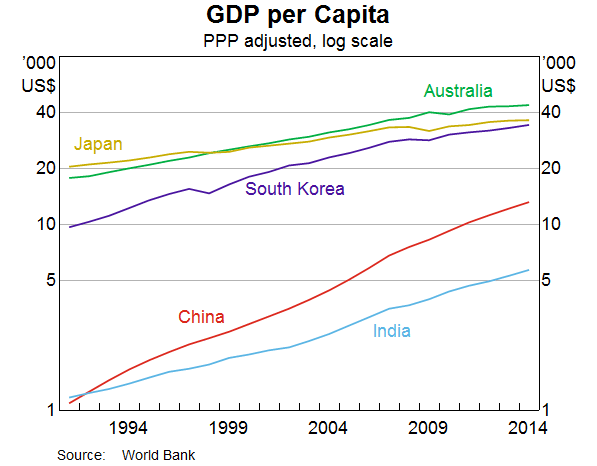
Key drivers of China's growth over the past few decades have included industrialisation, urbanisation and favourable demographic trends. A range of other factors have also contributed, including:
- entry into the World Trade Organization (WTO) in 2001, underpinning China's emergence as the largest exporter of manufactured goods
- a wave of privatisations for many inefficient state-owned enterprises (SOEs) in the late 1990s
- the emergence of private housing markets in the 1990s
- and, more recently, policy stimulus undertaken in response to the global financial crisis.
The Chinese economy has changed significantly, from one primarily dominated by agriculture, to one driven by the industrial and service sectors. The rapid emergence of China's industrial economy has been associated with strong investment growth in manufacturing and infrastructure (Graph 2). Even by emerging market economy standards, China's development has been characterised by very high levels of investment, underpinned by a high and rising rate of household saving (Graph 3).
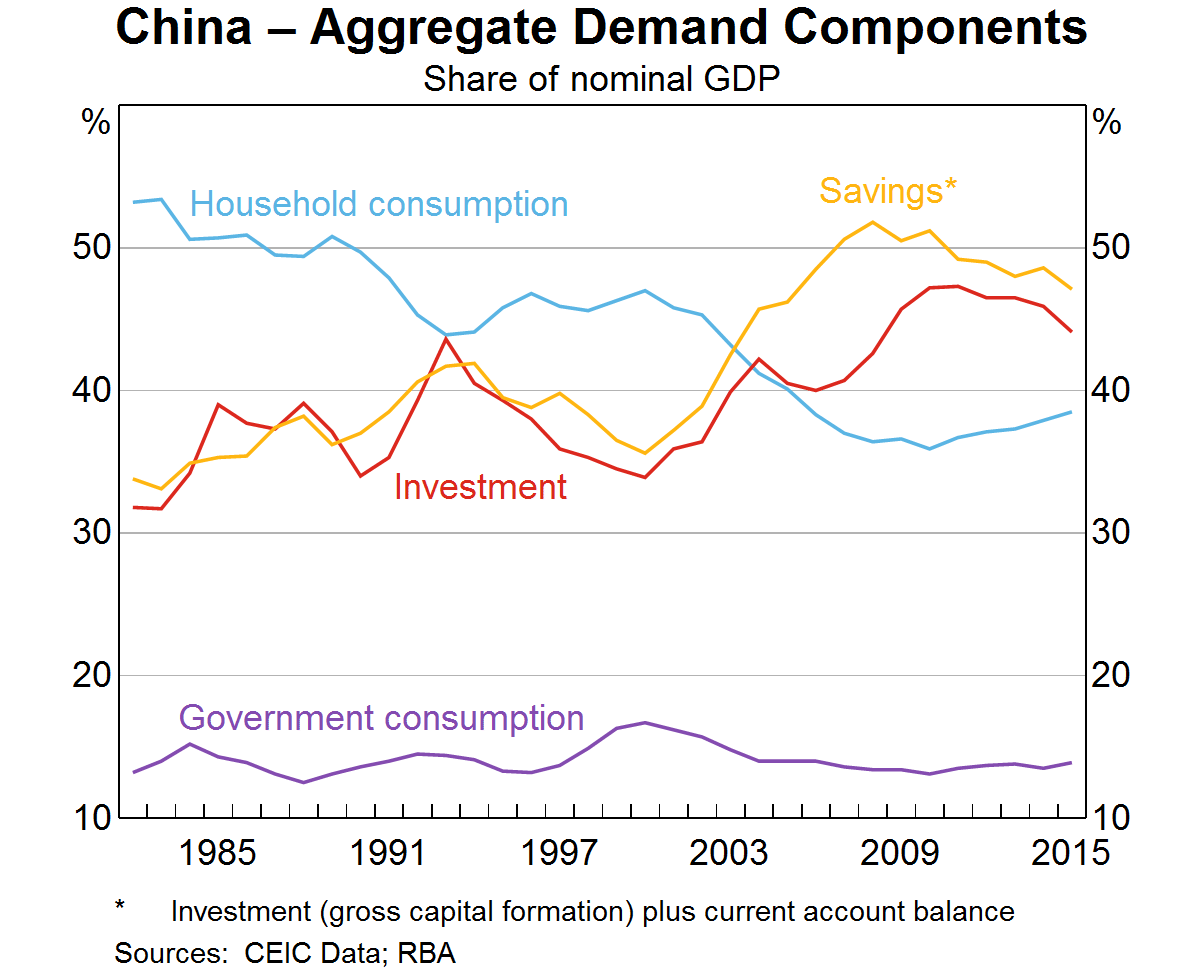
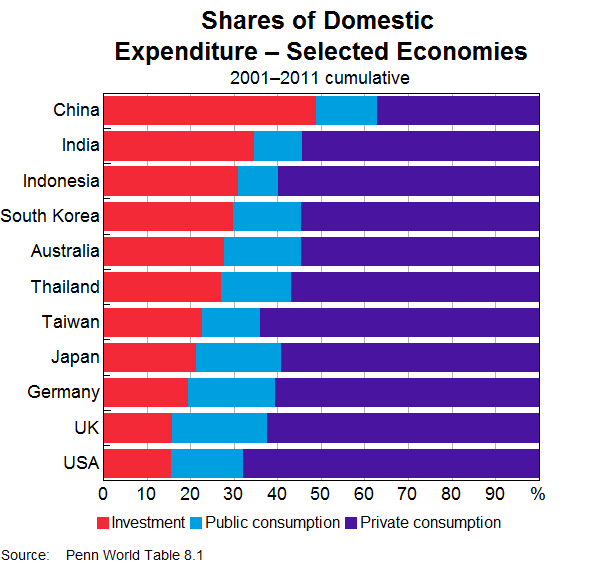
Against this background, the Chinese Government's stimulus policies adopted amid the global financial crisis led to a boom in debt-funded infrastructure investment and construction of residential and commercial properties. While these policies supported China's economic activity and promoted urbanisation, they also exacerbated what was arguably an already ‘unbalanced’ pattern of growth and the rise in debt contributed to the emergence of substantial financial risks.
Moderating Growth in China
Despite the stimulus following the global financial crisis, annual growth peaked in 2007 (Graph 4). As an aside, it is worth remembering that while China's growth is slower than it was 10 years ago, its contribution to global output growth is greater now because the Chinese economy is so much larger than it was.
In terms of output, the moderation in growth has been reflected in a slowdown in the industrial sector, while growth in the services sector has been more resilient. At the same time, on the expenditure side of the ledger, investment growth has declined while consumption growth has been relatively persistent.

The moderation in the growth of overall activity reflects a combination of longer-term and shorter-term factors. One prominent long-term factor has been the reversal of China's ‘demographic dividend’. The working-age population has reached its peak and is in decline.[2] A second persistent factor is the decline in the growth of productivity.[3] Both labour and total factor productivity experienced periods of rapid growth in the 1980s, 1990s and early 2000s following market-oriented reforms and increased openness to trade and investment (Graph 5). Urbanisation also underpinned high rates of productivity growth as people moved from relatively unproductive jobs in agriculture to more productive jobs in cities. However, since the late 2000s productivity growth has declined, as the positive effect of earlier reforms faded.
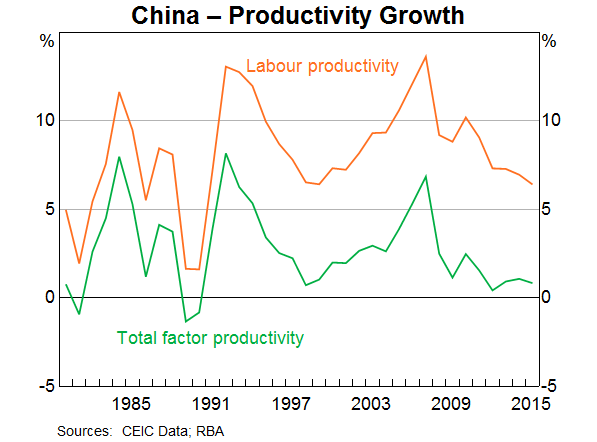
As in many other economies, housing demand has been an important driver of China's growth. Earlier development of private housing markets led to a sharp rise in residential investment (as a share of GDP) from the early 2000s (Graph 6).[4] But the pace of growth in housing investment has declined and has made a relatively modest contribution to Chinese growth of late.
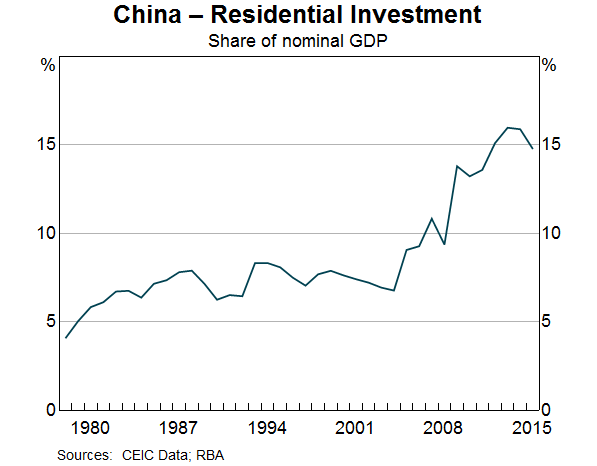
One long-term factor affecting housing demand is the slowdown in the growth of the working-age population, which means that China is also passing its peak in household formation.[5] A shorter-term influence is the substantial rise in the stock of unsold housing in a range of smaller cities, as developers built in anticipation of urbanisation that did not materialise as rapidly as expected. It will take time for these inventories to be reduced and for market signals to direct investment to locations with the best prospects for urbanisation. Further urbanisation, and demand for larger and higher-quality housing as Chinese incomes grow, will continue to underpin residential housing demand for some time. But as markets become saturated, housing is likely to become a less powerful engine of Chinese growth.
The slowdown in residential property investment over the past few years has affected heavy industries that produce construction materials, including steel. The weakness in demand of late, combined with earlier strength of investment, has led to a rise in excess capacity in a range of manufacturing and mining industries, and widespread deflation in industrial prices. Growth of profits in the industrial sector is now the weakest it has been since the non-performing loan ‘crisis’ of the late 1990s (Graph 7).
Excess capacity in the industrial sector has been associated with the phenomenon of so-called ‘zombie firms’ – enterprises that are making losses but still attracting financial resources.[6] In many cases, these are local government SOEs with substantial social welfare obligations, which leads to understandable resistance to closure. The ‘supply-side’ reform initiative announced by central government authorities late last year has set goals for the closure of excess capacity in coal and steel over the next few years.
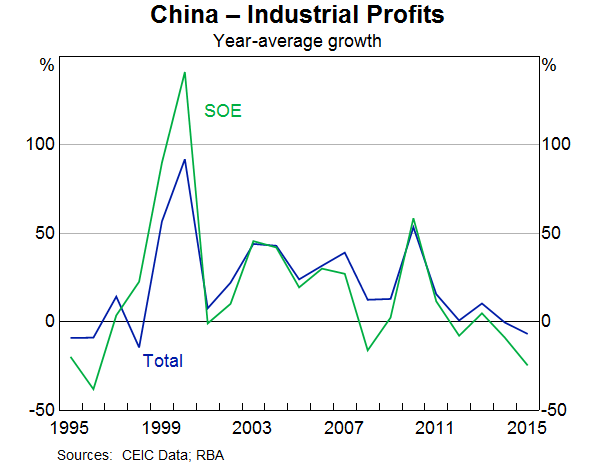
Evidence of poor returns in manufacturing is mirrored in declining returns to investment for the Chinese economy overall. Rough estimates suggest that the return on capital in China has fallen relative to the average cost of finance, largely reflecting a rapid increase in the capital-output ratio since the late 2000s (Graph 8).[7]
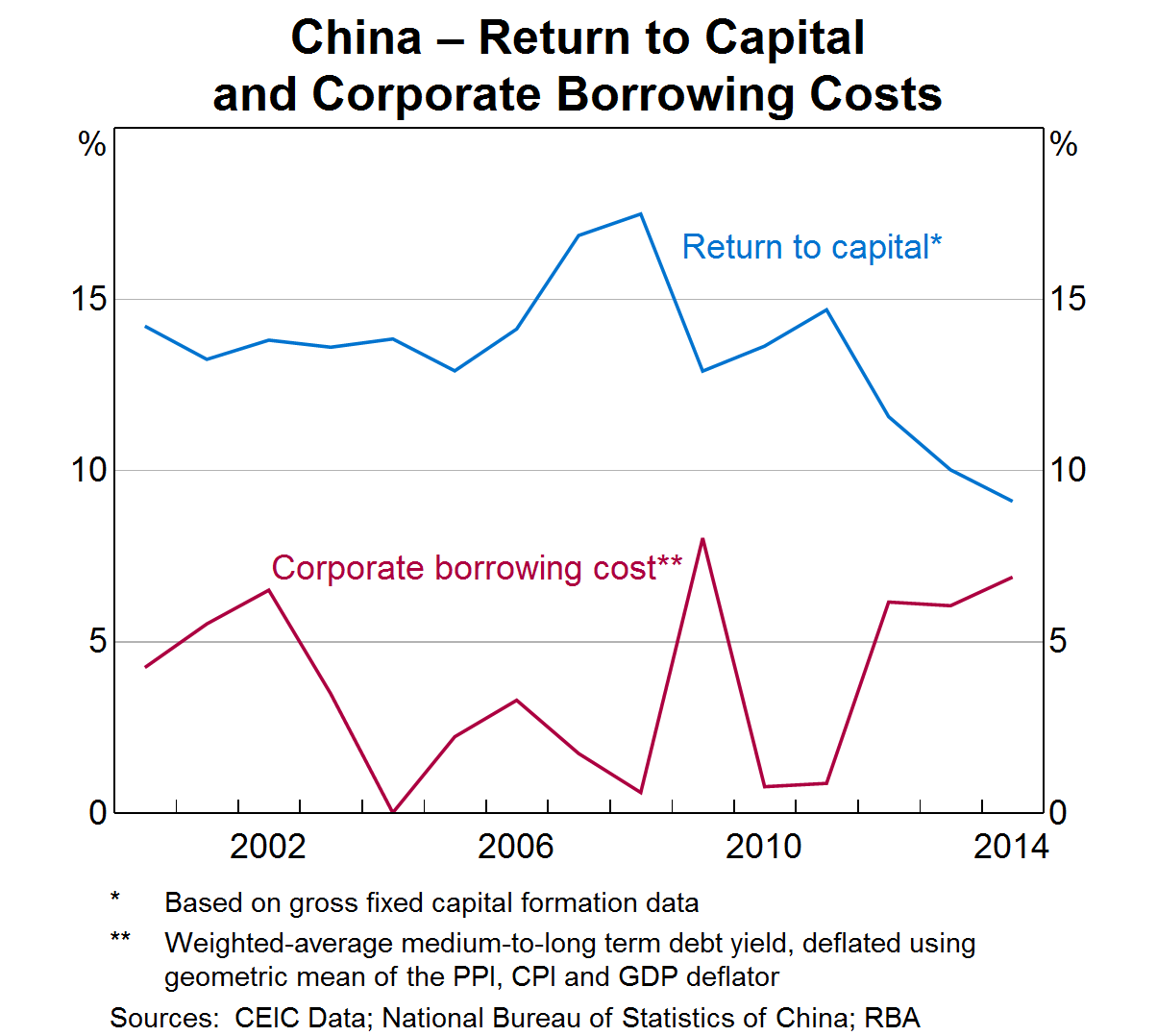
Prospects for Rebalancing
In contrast to the weakness in profits, the share of income going to labour now appears to be rising, reversing the decline seen over the past decade.[8] Accordingly, it is reasonable to expect that, over time, the composition of demand will tilt towards consumption and away from investment. Indeed, there are tentative signs that this ‘rebalancing’ may have started in the past few years.
However, Chinese consumption growth is already very strong and, historically, it has been rare for economies to experience stable and strong consumption growth during such a rebalancing. In China, as in many economies, investment tends to create sizeable demand for industrial goods, while consumption demand is increasingly focused on services. Thus, a shift in the composition of demand from investment to consumption is likely to be accompanied by resources moving from the capital-intensive industrial sector towards the more labour-intensive services sector. Achieving that in a smooth manner will be a significant challenge. In particular, the move of workers from industry to the services sector is unlikely to be seamless and could pose risks for employment and household income.
Any decline in the growth rate of household incomes is likely to pose a risk to consumption. This is because Chinese households are likely to maintain their high rates of saving.[9] In part, that desire reflects the significant gaps in public pension and health insurance systems and incomplete access of many migrant workers to social security.
In short, the limited prospects for stronger consumption growth and the declining returns to investment suggest that the bulk of the rebalancing over coming years is likely to be accomplished through slower investment growth. Other things being equal, this would entail a further easing in growth of activity overall.
Competing Objectives and Rising Risks
The Chinese authorities acknowledge the challenges posed by the various objectives they have set themselves. A key objective is to double 2010 income levels by 2020. This would require annual average growth of 6.5 per cent over the next few years.[10]
By itself, this might prove challenging in the face of unfavourable developments affecting the longer-run determinants of growth. In particular, the prospects for a rapid turnaround in productivity growth would appear to be rather limited given the gradual pace of economic reforms in recent years. But the government has ambitious reform plans, including:
- increasing the transparency of local government finances
- staged reform of the household registration (hukou) system
- increasing the coverage and sustainability of pension schemes and developing a national health insurance safety net
- and reforming SOEs, in part through consolidation, to create efficiencies.
Some early, but gradual, progress has been evident in these areas.
At the same time, the authorities would like to encourage the rebalancing of demand growth away from investment and to slow the accumulation of debt, at least within the heavily indebted corporate sector. However, over recent years meeting short-term growth targets appears to have taken precedence over plans to place growth and financing on a more sustainable footing.[11]
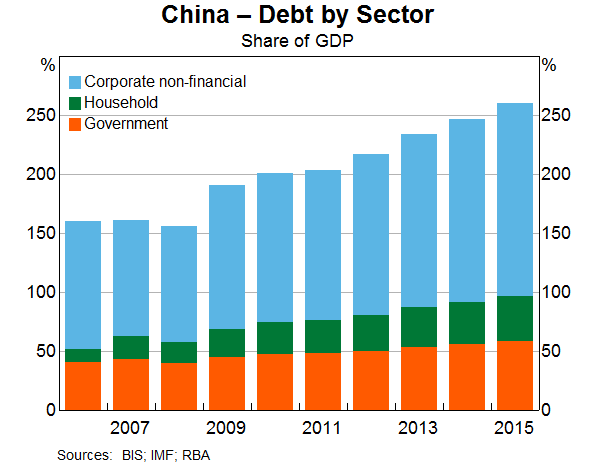
Over the past year, meeting the government's short-term growth goals required policymakers to pursue more stimulatory macroeconomic policies. This has been achieved through cuts to benchmark interest rates, an easing in fiscal policy and a relaxation of housing market restrictions – all while accommodating a faster pace of debt accumulation.[12] Overall, these measures have tended to stimulate investment – in housing and public infrastructure – more so than consumption or private investment. Indeed, there has been a return to growth in housing prices, a pick-up in housing sales and a recovery in residential investment.[13]
The trend rise in the ratio of debt to GDP since the global financial crisis has continued. Although estimates vary somewhat, this has led China's total (public and private) debt to rise to around 250 per cent of GDP (Graph 9).[14] This is still below that of several advanced economies, but it stands out among emerging market economies given China's relatively modest stage of economic development.
The high level and rapid growth of debt in China increases its vulnerability to adverse shocks. Reflecting the investment-driven nature of the expansion since 2008, the rise in debt has been concentrated in the corporate sector and local governments’ off-balance sheet vehicles that have been responsible for funding substantial infrastructure investment. There is a risk that defaults on these debts could impose significant losses on financial institutions and could lead to a general loss of confidence and a tendency for liquidity to recede in a range of funding markets.
To date, efforts by policymakers to address risks associated with the build-up in debt have focused on restructuring local government debt. High-interest off-balance sheet funding has been swapped with the issuance of low-interest local government bonds; that is good for local governments but comes at the cost of putting more pressure on banks and other lenders by reducing their interest income. With regard to addressing financial risks in the corporate sector, so far, the central government appears to have taken a relatively hands-off approach, leaving it to banks and local governments to address issues as they arise. The authorities also appear more willing tolerate some defaults in the bond market, which has grown rapidly as a source of funding in the past couple of years. This will help improve the allocation of credit overtime, but this funding channel remains vulnerable to the possibility of a sharp reassessment of risks by lenders.
So far, there are no outward signs of distress in the banking system, despite falling profit growth and rising non-performing loans (Graph 10). But the structure of the financial system continues to evolve rapidly, raising concerns about the robustness of the funding position of some of the faster-growing segments of the industry, particularly smaller banks and non-bank financial intermediaries. One concern is that some smaller lenders have large exposures to regions and industries currently experiencing economic hardship. Likewise, institutions involved in complex ‘shadow banking’ transactions could experience problems if a shift of sentiment in funding markets forces these types of activities to be unwound.
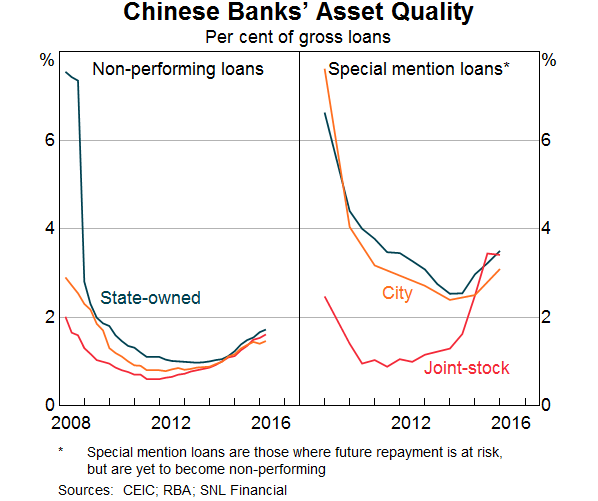
It is worth noting, however, that compared with many cases of heavily indebted emerging economies that have faced financial problems in the past, China's debt is largely domestic. A considerable portion of that has arisen from state-owned or controlled financial institutions lending to state-owned or state-controlled enterprises, which to some extent allows the problem to be handled within the official ‘family’.[15] Moreover, the debt has largely been funded by the household sector, which has sustained a very high rate of saving. Although this does not preclude the possibility of substantial disruption in the financial system, it does provide some leeway for authorities attempting to ensure that the financial system remains liquid. The extent of that leeway will potentially depend on the effectiveness of capital controls. But that is a topic for another time.
Conclusions
China's economy has grown at an impressive rate over the past 20–25 years or so. However, growth has moderated over recent years and is projected to ease further as the longer-term drivers of that growth recede. Moreover, the pattern of development has given rise to significant imbalances. High and rising levels of corporate debt in the face of excess capacity and declining profitability suggests a greater risk of corporate defaults, which could ultimately lead to disruption in the financial system.
There have been many positive signals from the leadership about improving the sustainability of growth, including recent calls to implement so-called ‘supply-side’ reforms, with a view to facilitating deleveraging in the corporate sector and reducing excess capacity in key industries. Nonetheless, the direction of policy so far has tended towards more, rather than less, accommodative monetary and fiscal settings. To the extent that this represents a re-prioritisation of short-term objectives over longer-term sustainability, it may increase the likelihood of a future disruptive adjustment. Even so, the authorities will no doubt respond if the economy experiences shocks that might otherwise lead to a so called ‘hard landing’ for the economy as a whole. In other words, they are aware of the challenges and have scope to respond if the economy turns out to be much weaker than expected.
For Australia, the primary risk posed by the uncertain outlook in China is to commodity prices and the exports of goods (particularly resources) and services. A depreciation of the Australian dollar in response to negative developments in external conditions could be expected to act as a buffer in the way that it has in the past.
While I have focused today on a number of the downside risks, we should not lose sight of the fact that the central scenario over the next few years is for a gradual moderation of growth in China. And over the longer term, there is a lot of room for further development of the Chinese economy, which will provide Australia with many economic opportunities. While the value of non-rural exports to China have declined with the fall in commodity prices, the value of other exports to China have been rising strongly of late (Graph 11). We are likely to continue to benefit from rising incomes and the associated demand for high-quality food, goods and a wide array of household and business services from China and the region more broadly.
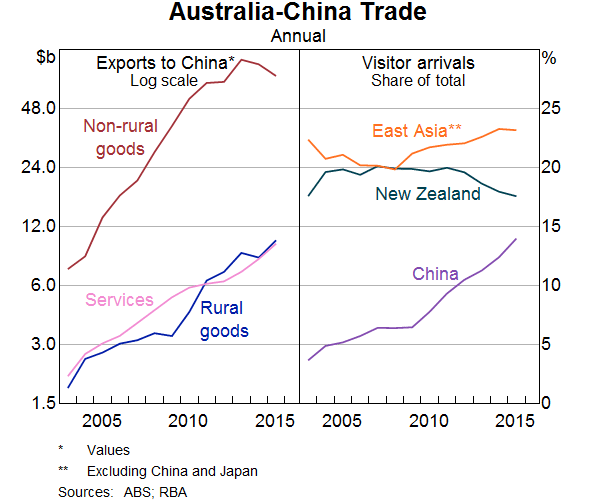
Endnotes
I thank Arianna Cowling, Patrick D'Arcy, Iris Day, Chris Read, Ivan Roberts and Andrew Zurawski for invaluable assistance in preparing these remarks. [*]
Note that our forecasts are similar to those of both the International Monetary Fund and Consensus. See, IMF (2016), World Economic Outlook, April 2016. [1]
The relaxation of the one-child policy is unlikely to have a substantive effect on population ageing, at least not in the short-to-medium term (Lim J and A Cowling (2016), ‘China's Demographic Outlook’, RBA Bulletin, June, pp 35–42.) [2]
Some weakness in productivity growth may relate to a cyclical slowing in the industrial sector, whereby producers (particularly SOEs) have held on to labour even though production has declined. [3]
The combined direct and indirect share of GDP growth accounted for by housing investment is estimated to have been as high as 30 per cent or so in recent years. See, Ma G, I Roberts and G Kelly (2016), ‘A Rebalancing Chinese Economy: Challenges and International Implications’, Paper presented at the RBA Conference ‘Structural Change in China: Implications for Australia and the World’, Sydney, 17–18 March. [4]
The working-age population for urban centres has not yet peaked (given ongoing urbanisation), although its growth rate is gradually declining. Also, earlier rapid growth in housing demand was partly a response to unmet demand for private housing that had built up under the old state-dominated housing system. This source of growth was always going to wane, as the backlog has been progressively satisfied. [5]
The term has been used publicly by the Premier, Li Keqiang, to describe such firms. For example, see: Keqiang L (2016), Report on the Work of the Government’ available at <http://english.gov.cn/premier/news/2016/03/17/content_281475309417987.htm>, delivered at the Fourth Session of the 12th National People's Congress of the People's Republic of China, 5 March. [6]
See Ma, Roberts and Kelly (2016). [7]
This shift in factor income shares towards labour is a sign that price signals in the Chinese economy are increasingly reflecting the investment-heavy pattern of expenditure mentioned earlier. [8]
See Ma, Roberts and Kelly (2016). [9]
This goal was first stated at the 18th National Congress of the Communist Party of China (CPC) and reiterated at the National People's Congress in March 2016. See Jintao, H, ‘Report of Hu Jintao to the 18th CPC National Congress’ (2012) available at <http://www.china.org.cn/china/18th_cpc_congress/2012-11/16/content_27137540.htm> and Keqiang, L, ‘Report on the Work of the Government’ (2016) available at <http://online.wsj.com/public/resources/documents/NPC2016_WorkReport_English.pdf>. [10]
A recent article in the People's Daily, the most authoritative official media source, has highlighted that the government faces a dilemma in managing the economy; the article itself can be seen as an attempt by the authorities to manage expectations. See, People's Daily (2016), ‘An Authoritative Person Discusses the Current Chinese Economy’, 9 May, p 1. Available at <http://paper.people.com.cn/rmrb/html/2016-05/09/nw.D110000renmrb_20160509_6-01.htm>. [11]
The rate of growth of financing has picked up noticeably (to around 17 per cent in year-ended terms, once the swapping of local government off-balance sheet borrowing for local government bonds has been taken into account). [12]
For a few of the largest cities, conditions have strengthened so much that the local authorities have been tightening up measures designed to restrict demand, most notably in Shenzhen and Shanghai. [13]
For example, see <http://www.bis.org/statistics/totcredit/tables_f.pdf>. [14]
There is a tension between the government maintaining the smooth functioning of financial markets through implicit guarantees of financial institutions, and the problems of moral hazard and inefficient resource allocation that can result. [15]